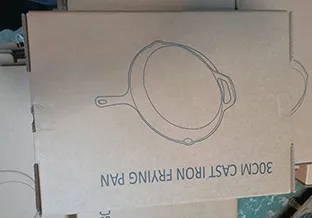
Durable Cast Iron Cookware for Perfect Skillet Meals Every Time
The Versatility of an Iron Skillet Pot
When it comes to kitchen essentials, few items can rival the versatility of an iron skillet pot. This traditional cooking vessel has been cherished by home cooks and professional chefs alike for centuries. Known for its ability to distribute heat evenly, retain warmth, and develop a natural non-stick surface over time, the iron skillet pot is not just a tool but a cherished companion in the culinary world.
First, let’s dive into the history of the iron skillet. Dating back to ancient times, cast iron cookware was widely used due to its durability and heat retention properties. Early versions of the skillet were often handcrafted from molten iron and evolved into the iconic design we recognize today. Throughout history, these skillets have transcended cultural boundaries, appearing in kitchens across the globe, from Southern U.S. fried chicken to Spanish paella.
One of the most appealing aspects of an iron skillet pot is its incredible versatility. This cookware allows you to sear, sauté, bake, and even fry. With an iron skillet, you can start a dish on the stovetop and seamlessly transition it to the oven, creating a perfect one-pot meal. Imagine preparing a crusty cornbread or a savory frittata with ease—simply finish cooking on the stovetop and transfer it to the oven for a golden-brown top. This flexibility makes it a staple for everything from breakfast to dinner, and even dessert.
An iron skillet pot is also celebrated for its superior heat retention
. Once heated, it remains hot for a significant amount of time, allowing for beautifully caramelized vegetables and perfectly seared meats. The ability to maintain consistent cooking temperatures means that seasoned chefs often rely on it for delicate tasks such as sautéing or making sauces. Additionally, this heat retention minimizes the need for frequent heat adjustments, leading to energy savings in the kitchen.iron skillet pot

Another noteworthy benefit of using an iron skillet pot is its durability. With proper care, these skillets can last a lifetime and even be passed down through generations. Unlike other cooking materials, cast iron improves with age. The more it is used, the better the cooking surface becomes, forming a natural patina that enhances flavor and reduces the need for added oils. However, it is essential to understand the care required—regular seasoning and proper cleaning are crucial to maintaining its quality.
Moreover, cooking with cast iron is not only practical but also offers health benefits. Iron is an essential nutrient that plays a vital role in our bodies. Cooking in cast iron can increase the iron content of foods, particularly when cooking acidic foods like tomato sauce. This can be particularly beneficial for individuals who may have difficulty meeting their daily iron intake.
Rustic and charming, an iron skillet pot adds character to any kitchen. Its aesthetic appeal makes it suitable for serving; you can bring your dish straight from the oven to the table, showcasing the craftsmanship of the skillet and the deliciousness of the meal. The deep, rich colors of a well-seasoned skillet convey a sense of warmth and tradition, making it an inviting centerpiece.
In conclusion, the iron skillet pot is much more than just a cooking tool. Its historical significance, versatile functionality, durability, health benefits, and aesthetic appeal make it an invaluable asset in any kitchen. Whether you are a novice cook or an experienced chef, incorporating an iron skillet pot into your culinary repertoire can elevate your cooking experience, allowing you to explore new flavors and techniques. So, dust off that old skillet, embrace its unique properties, and enjoy the delicious results that come from this timeless kitchen companion.
-
Season Cast Iron Perfectly with GPT-4 Turbo TipsNewsAug.01,2025
-
High Quality Cast Iron Cookware - Baixiang County Zhongda MachineryNewsAug.01,2025
-
Premium Cast Iron Pan: Durable & Perfect HeatNewsAug.01,2025
-
High Quality Kitchen Durable Black Round Cast Iron Cookware Pancake Crepe Pan-Baixiang County Zhongda Machinery Manufacturing Co., Ltd.NewsAug.01,2025
-
Cast Iron Cookware - Baixiang County Zhongda Machinery | Nonstick, Heat ResistanceNewsAug.01,2025
-
High Quality Kitchen Durable Black Round Cast Iron Cookware - Baixiang County Zhongda Machinery | Non-Stick, Heat Retention, DurableNewsJul.31,2025


